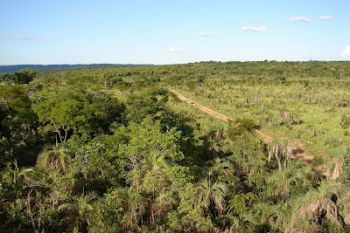By Claudia Pompa
 Mbaracayú Forest Biosphere ReservePalmira Paola Mereles is a 17 year old girl from the small, rural community of Ybyra Robana in Cannindeyu, a region in the north of Paraguay. For Paola and many girls from her impoverished community, the chances of getting a proper education and going to college have been simply a distant dream. Access to a good education is one of the best routes out of poverty, but for poor, rural young people in developing countries who aspire to earn a decent living, agricultural education is neither good, nor generally available—especially for girls. The Centro Educativo Mbaracayu (CEM) is trying to change this.
Mbaracayú Forest Biosphere ReservePalmira Paola Mereles is a 17 year old girl from the small, rural community of Ybyra Robana in Cannindeyu, a region in the north of Paraguay. For Paola and many girls from her impoverished community, the chances of getting a proper education and going to college have been simply a distant dream. Access to a good education is one of the best routes out of poverty, but for poor, rural young people in developing countries who aspire to earn a decent living, agricultural education is neither good, nor generally available—especially for girls. The Centro Educativo Mbaracayu (CEM) is trying to change this.
The CEM, an all-girl boarding school, is located in the UNESCO-recognized Mbaracayú Forest Biosphere Reserve, one of South America´s most important forest reserves, which is located in north-east Paraguay and is administered by the Moises Bertoni Foundation. The CEM seeks to empower young women to overcome poverty, transforming girls from poor farming families and indigenous communities near the reserve into ‘rural and environmental entrepreneurs’. After three years of education, girls studying at CEM graduate with a Technical Educational Degree in Environmental Science, which provides them with a broad understanding of current regulations related to the environment, management of a reserve and production. Additionally, the girls acquire a working knowledge of hospitality, since during their time at the school they are in charge of the school hotel. Through a combination of small-scale, on-campus agro-forestry and tourism projects, the school enables its students to develop the skills required to start their own businesses or to obtain jobs that pay fair wages.
The school is also culturally diverse. Girls from the nearby rural farming communities sit next to indigenous girls from the Ache and the Ava communities and “brasiguayas”, girls from Brazilian families living and working in Paraguay. This mix is something rarely seen in Paraguay. Yan Speranza, Executive Director of Moises Bertoni Foundation explains, “in any given day you can hear between four and five languages being spoken”. Understanding of different cultures and communities, which is promoted at the school, is an added value for development in an area characterized by conflict between communities.
Speranza also speaks of the importance of environmental conservation, promoted and taught at school. “Our philosophy is that environmental sustainability will only be attainable through people’s participation, in this case education. By educating this girls we are not only providing them with a better economic future, but we are also ensuring the protection of the reserve.”
In December 2011, after three years of schooling, living away from their families in the woods of a large natural reserve, 51 girls graduated from the CEM, one of them Palmira Paola. Today, Palmira Paola is a scholarship student at the University of the Earth in Costa Rica, one of the most prestigious schools for environmental studies. Palmira’s case is the perfect example of how education can help unleash an individual’s potential. The question is, how many other young women in Paraguay and from around the world have the same potential but lack opportunities such as those afforded by CEM?

